Construction Safety Risks of Metro Tunnels Constructed by the Mining Method in Wuhan City, China: A Structural Equation Model-Fuzzy Cognitive Map Hybrid Method
Abstract
:1. Introduction
2. Research Variables
| Stages | Abbreviation | Index | References |
|---|---|---|---|
| Advancing support | The design of the advanced support construction operation scheme is unreasonable. | Yue et al. (2016) [30], Leung et al. (2017) [31], Song et al. (2021) [32] | |
| Material selection is not up to standard. | Wang et al. (2021) [33] | ||
| The quality of the advanced support is inferior. | Zhang et al. (2018) [34], Xu et al. (2017) [35] | ||
| The grouting construction effect is poor. | Bai (2020) [36], Liu et al. (2021) [37] | ||
| Tunnel excavation | Unreasonable selection of excavation methods. | Yue et al. (2016) [30], Zhang et al. (2018) [34], Liu et al. (2021) [37] | |
| The size of the excavation section does not meet the design requirements. | Rahimi et al. (2021) [38], Meye et al. (2020) [39], He et al. (2022) [40] | ||
| Improper control of the excavation profile. | Rahimi et al. (2021) [38], He et al. (2022) [40] | ||
| Unreasonable determination of the excavation footage and sequence. | Zhang et al. (2018) [34], Bai (2020) [36], Zheng et al. (2022) [41] | ||
| Over-excavation and under-excavation. | Rahimi et al. (2021) [38], He et al. (2022) [40], Qiu et al. (2020) [42] | ||
| Primary support | The installation and construction of steel mesh do not meet the specification requirements. | Xu et al. (2017) [35], Huang et al. (2021) [43] | |
| The installation and construction of the steel frame do not meet the specification requirements. | Xu et al. (2017) [35], Huang et al. (2021) [43], Huang et al. (2022) [44] | ||
| The construction quality of the mortar bolt is inferior. | Yue et al. (2016) [30], Xu et al. (2017) [35], Huang et al. (2022) [44] | ||
| The shotcrete is not up to standard. | Xu et al. (2017) [35], Bai (2020) [36], Huang et al. (2022) [44], Gong et al. (2023) [45] | ||
| The backfill grouting behind the initial support is not in place. | Wang et al. (2021) [33], Xu et al. (2017) [35], Huang et al. (2022) [44] | ||
| Structure waterproof | The waterproof concrete construction quality is inferior. | Wang et al. (2019) [46], Pelz et al. (2022) [47], Ai et al. (2022) [48] | |
| The waterproof plate and waterproof coil are not applicable. | Wang et al. (2019) [46], Pelz et al. (2022) [47], Ai et al. (2022) [48] | ||
| The deviation of the deformation joint is too large. | Meye et al. (2020) [39], Luciani et al. (2019) [49] | ||
| Seal failure of construction joint and wall pipe. | Luciani et al. (2019) [49], Fan et al. (2021) [50] | ||
| Secondary lining | The quality of lining construction is not up to standard. | Tian (2015) [51] | |
| The quality of rebar processing is poor. | Wang et al. (2021) [33], Tian (2015) [51], Wang et al. (2022) [52] | ||
| The safety factor of the lining die frame and trolley is not up to standard. | Qiu et al. (2020) [42], Tian (2015) [51] | ||
| Inadequate concrete placement and curing conditions. | Qiu et al. (2020) [42], Tian (2015) [51], Wang et al. (2022) [52] | ||
| Auxiliary measures | The water table is not properly controlled. | Liu et al. (2021) [37], Wang et al. (2019) [53] | |
| The organization and management of on-site transportation are not coordinated. | Leung et al. (2017) [31], Qiu et al. (2020) [42], Kang et al. (2017) [54] | ||
| The monitoring and measurement scheme is not complete. | Bai (2020) [36], Liu et al. (2021) [37], Ghorbani et al. (2012) [55] | ||
| Insufficient construction ventilation. | Jalali et al. (2011) [56], Nie et al. (2022) [57] |
3. Model Development
3.1. Step 1: Research Data Acquisition
3.2. Step 2: Development of SEM
3.3. Step 3: Verification of SEM
3.4. Step 4: Development of the FCM
3.5. Step 5: Reasoning of FCM
3.6. Step 6: Predictive Analysis and Diagnostic Analysis
4. Empirical Analysis Results
4.1. Step 1: Verification of SEM
4.2. Step 2: Modification of SEM
4.3. Step 3: SEM Analysis
4.4. Step 4: Development of FCM
4.5. Step 5: Predictive Analysis of FCM
4.6. Step 6: Diagnostic Analysis of FCM
5. Discussion
6. Conclusions
Author Contributions
Funding
Conflicts of Interest
Nomenclature
| Parameters | |
| C1 | Advancing support |
| C2 | Tunnel excavation |
| C3 | Primary support |
| C4 | Structure waterproof |
| C5 | Secondary lining |
| C6 | Auxiliary measures |
| CSR | Construction safety risk |
| PR | Project risk |
| Variables | |
| Endogenous variable | |
| Exogenous variable | |
| Observational variable of endogenous variable | |
| Observational variable of exogenous variable | |
| Action of exogenous variable on endogenous variable | |
| The relationship among endogenous variables | |
| Factor loading | |
| Measurement error of endogenous variable | |
| Measurement error of variable | |
| Measurement error of variable | |
| Acronyms | |
| CR | Composite reliability |
| AVE | Average variance extraction |
| RMR | Root mean square residua |
| RMSEA | Root mean square error of approximation |
| GFI | Goodness of fit index |
| AGFI | Adjusted goodness of fit index |
| IFI | Incremental fit index |
| CFI | Comparative fit index |
| NFI | Normal fit index |
| TLI | Tucker–Lewis index |
| PGFI | Parsimony good fit index |
| PNFI | Parsimony norm fit index |
| CMIN/DF | Discrepancy divided by degree of freedom |
References
- Central People’s Government of Prc. The Fourteenth Five-Year Plan for National Economic and Social Development of the People’s Republic of China and the Outline of the Long-Term Goals for 2035 [Z]. 2021. Available online: http://www.gov.cn/xinwen/2021-03/13/content_5592681.htm (accessed on 5 April 2023).
- Ding, L.; Xu, J. A review of metro construction in China: Organization, market, cost, safety and schedule. Front. Eng. Manag. 2017, 4, 4–19. [Google Scholar] [CrossRef]
- Suo, Q.; Wang, L.; Yao, T.; Wang, Z. Promoting Metro Operation Safety by Exploring Metro Operation Accident Network. J. Syst. Sci. Inf. 2021, 9, 455–468. [Google Scholar] [CrossRef]
- Shi, X.; Liu, Y.; Zhang, D.; Li, R.; Qiao, Y.; Opoku, A.; Cui, C. Influencing Factors of Human Errors in Metro Construction Based on Structural Equation Modeling (SEM). Buildings 2022, 12, 1498. [Google Scholar] [CrossRef]
- Liu, B.; Li, T.; Chang, W.; Han, Y.; Fu, C.; Yu, Z. Mechanical response of horseshoe-shaped tunnel lining to undercrossing construction of a new subway station. Tunn. Undergr. Space Technol. 2022, 128, 104652. [Google Scholar] [CrossRef]
- Kim, D.; Pham, K.; Oh, J.-Y.; Lee, S.-J.; Choi, H. Classification of surface settlement levels induced by TBM driving in urban areas using random forest with data-driven feature selection. Autom. Constr. 2022, 135, 104109. [Google Scholar] [CrossRef]
- Dai, C.-Q.; Zhao, Z.-H. Fuzzy comprehensive evaluation model for construction risk analysis in urban subway. Int. J. Model. Simul. Sci. Comput. 2015, 6, 17–34. [Google Scholar] [CrossRef]
- Mehryar, S.; Surminski, S. Investigating flood resilience perceptions and supporting collective decision-making through fuzzy cognitive mapping. Sci. Total. Environ. 2022, 837, 155854. [Google Scholar] [CrossRef]
- Wang, Q.; Zhu, K.; Wang, J.; Guo, P.; Shen, W. Bibliometric analysis of engineering project risk management literature. Chin. J. Saf. Sci. 2021, 31, 15–23. [Google Scholar] [CrossRef]
- Fang, Q.; Zhang, D.; Hou, Y.; Li, B.; Sun, F. Safety risk control technology of urban subway with shallow tunnel construction method. J. Beijing Jiaotong Univ. 2010, 34, 16–21. [Google Scholar]
- Gui, D.; Tong, J.; Wang, M.; Deng, K.; Zhao, S. Safety evaluation of support structure of the tunnel excavated by mining method with arching and backfilling. Mod. Tunn. Technol. 2020, 57, 110–116. [Google Scholar] [CrossRef]
- Wu, B.; Cai, Q.; Liu, C.; Hunag, W.; Xie, Y. Multi-scale evaluation model and application of safety risk in urban subway station construction. J. Saf. Environ. 2023, 23, 633–641. [Google Scholar] [CrossRef]
- Saedi, A.; Majid, A.A.; Isa, Z. Relationships between safety climate and safety participation in the petroleum industry: A structural equation modeling approach. Saf. Sci. 2019, 121, 240–248. [Google Scholar] [CrossRef]
- Liu, J.; Zhao, X.; Yan, P. Risk Paths in International Construction Projects: Case Study from Chinese Contractors. J. Constr. Eng. Manag. 2016, 142, 016002. [Google Scholar] [CrossRef]
- Gunduz, M.; Birgonul, M.T.; Ozdemir, M. Development of a safety performance index assessment tool by using a fuzzy structural equation model for construction sites. Autom. Constr. 2018, 85, 124–134. [Google Scholar] [CrossRef]
- Zhang, J.; Xiang, P.; Zhang, R.; Chen, D.; Ren, Y. Mediating Effect of Risk Propensity between Personality Traits and Unsafe Behavioral Intention of Construction Workers. J. Constr. Eng. Manag. 2020, 146, 04020023. [Google Scholar] [CrossRef]
- Fonseca, J.P.; Ferreira, F.A.; Pereira, L.F.; Govindan, K.; Meidutė-Kavaliauskienė, I. Analyzing determinants of environmental conduct in small and medium-sized enterprises: A sociotechnical approach. J. Clean. Prod. 2020, 256, 120380. [Google Scholar] [CrossRef]
- Morone, P.; Yilan, G.; Imbert, E. Using fuzzy cognitive maps to identify better policy strategies to valorize organic waste flows: An Italian case study. J. Clean. Prod. 2021, 319, 128722. [Google Scholar] [CrossRef]
- Soner, O.; Asan, U.; Celik, M. Use of HFACS–FCM in fire prevention modelling on board ships. Saf. Sci. 2015, 77, 25–41. [Google Scholar] [CrossRef]
- Khanzadi, M.; Nasirzadeh, F.; Dashti, M.S. Fuzzy Cognitive Map Approach to Analyze Causes of Change Orders in Construction Projects. J. Constr. Eng. Manag. 2018, 144, 04017111. [Google Scholar] [CrossRef]
- Wang, L.; Liu, Q.; Dong, S.; Soares, C.G. Effectiveness assessment of ship navigation safety countermeasures using fuzzy cognitive maps. Saf. Sci. 2019, 117, 352–364. [Google Scholar] [CrossRef]
- Amirkhani, A.; Nasiriyan-Rad, H.; Papageorgiou, E.I. A Novel Fuzzy Inference Approach: Neuro-fuzzy Cognitive Map. Int. J. Fuzzy Syst. 2019, 22, 859–872. [Google Scholar] [CrossRef]
- Ding, L.; Zhang, L.; Wu, X.; Skibniewski, M.J.; Qunzhou, Y. Safety management in tunnel construction: Case study of Wuhan metro construction in China. Saf. Sci. 2014, 62, 8–15. [Google Scholar] [CrossRef]
- Zhai, Q.; Gu, W.; Jin, Z. Safety risk assessment for a subway connecting passage constructed by freezing method. Mod. Tunn. Technol. 2021, 58, 57–66. [Google Scholar] [CrossRef]
- Kang, J.; Zhang, J.; Gao, J. Improving performance evaluation of health, safety and environment management system by combining fuzzy cognitive maps and relative degree analysis. Saf. Sci. 2016, 87, 92–100. [Google Scholar] [CrossRef]
- Keshtiban, P.M.; Onari, M.A.; Shokri, K.; Rezaee, M.J. Enhancing risk assessment of manufacturing production process integrating failure modes and sequential fuzzy cognitive map. Qual. Eng. 2022, 34, 191–204. [Google Scholar] [CrossRef]
- Toutounchian, S.; Abbaspour, M.; Dana, T.; Abedi, Z. Design of a safety cost estimation parametric model in oil and gas engineering, procurement and construction contracts. Saf. Sci. 2018, 106, 35–46. [Google Scholar] [CrossRef]
- Hillson, D. Using a Risk Breakdown Structure in project management. J. Facil. Manag. 2003, 2, 85–97. [Google Scholar] [CrossRef]
- Hamzaoui, F.; Taillandier, F.; Mehdizadeh, R.; Breysse, D.; Allal, A. Evolutive Risk Breakdown Structure for managing construction project risks: Application to a railway project in Algeria. Eur. J. Environ. Civ. Eng. 2014, 19, 238–262. [Google Scholar] [CrossRef]
- Yue, J.; Leng, W.; An, Y.; Liu, Y.; Luo, H. Mechanical behavior and construction measures of transfixing safely to underwater tunnels with small clear spacing by shallow mining method. J. Nat. Disasters 2016, 25, 142–151. [Google Scholar] [CrossRef]
- Leung, T.; Chen, J. Application of new Austrian tunnelling method to a large span trinocular cross section tunnel. Chin. J. Rock Mech. Eng. 2017, 36, 2755–2766. [Google Scholar] [CrossRef]
- Song, Z.; Su, W.; Tian, X.; Zhang, Y.; Zhou, G. Risk Analysis of Tunnel Construction Scheme Change based on Field Monitoring and Numerical Analysis. Adv. Civ. Eng. 2021, 2021, 1–15. [Google Scholar] [CrossRef]
- Wang, C.; Zhu, F.; Luo, X.; Zhang, C.; Tian, J.; Li, H.; Guo, Y. Study on construction risk assessment of tunnel reconstruction and expansion works. Mod. Tunn. Technol. 2021, 58, 63–70. [Google Scholar] [CrossRef]
- Zhang, X.; Wang, M.; Zhou, B.; Wang, X. Influence of factors on collapse risk of loess tunnel: A multi-index assessment model. J. Eng. Des. Technol. 2018, 16, 734–749. [Google Scholar] [CrossRef]
- Xu, Y.; Yu, S.; Zhang, Y. Detection and recognition of support structure diseases of metro tunnel constructed by mining method based on forward modeling. Tunn. Constr. 2017, 37, 179–184. [Google Scholar] [CrossRef]
- Bai, P. Settlement control techniques of the super-shallow buried large-span mined tunnel underneath an existing tunnel. Mod. Tunn. Technol. 2020, 57, 175–181. [Google Scholar] [CrossRef]
- Liu, B.; Ye, W.; Zhu, C.; Chen, R.; Huang, S.; Ni, X. Analysis on Treatment Effect of Mine Tunnel Construction Spring in Karst Area. Math. Probl. Eng. 2021, 2021, 5585054. [Google Scholar] [CrossRef]
- Rahimi, B.; Sharifzadeh, M.; Feng, X.-T. A comprehensive underground excavation design (CUED) methodology for geotechnical engineering design of deep underground mining and tunneling. Int. J. Rock Mech. Min. Sci. 2021, 143, 104684. [Google Scholar] [CrossRef]
- Meye, S.M.; Shen, Z. Numerical Simulation of the Influence of Tunnel Construction by Mining Method on the Seepage Field in Weathered Granite Stratum. Engineering 2020, 12, 424–456. [Google Scholar] [CrossRef]
- He, M.; Sui, Q.; Li, M.; Wang, Z.; Tao, Z. Compensation excavation method control for large deformation disaster of mountain soft rock tunnel. Int. J. Min. Sci. Technol. 2022, 32, 951–963. [Google Scholar] [CrossRef]
- Zheng, G.; Wang, R.; Lei, H.; Zhang, T.; Li, H. A novel sequential excavation method for constructing large-cross-section tunnels in soft ground: Practice and theory. Tunn. Undergr. Space Technol. 2022, 128, 104626. [Google Scholar] [CrossRef]
- Qiu, D.; Qu, C.; Xue, Y.; Zhou, B.; Li, X.; Ma, X.; Cui, J. A Comprehensive Assessment Method for Safety Risk of Gas Tunnel Construction Based on Fuzzy Bayesian Network. Pol. J. Environ. Stud. 2020, 29, 4269–4289. [Google Scholar] [CrossRef]
- Huang, F.; Gao, X. Study on the structural stability of mined tunnels with double-layer initial supporting arch cover in soil-rock composite strata based on the arch section constructed by SD method. Mod. Tunn. Technol. 2021, 58, 37–45. [Google Scholar] [CrossRef]
- Huang, M.; Song, Y.; Zhang, X.; Sun, T. Experimental study and engineering application of the spatial reticulated grid bolt-shotcrete support structure for excavation tunnels. Appl. Sci. 2022, 12, 8506. [Google Scholar] [CrossRef]
- Gong, C.; Kang, L.; Liu, L.; Lei, M.; Ding, W.; Yang, Z. A novel prediction model of packing density for single and hybrid steel fiber-aggregate mixtures. Powder Technol. 2023, 418, 118295. [Google Scholar] [CrossRef]
- Wang, X.; Li, S.; Xu, Z.; Hu, J.; Pan, D.; Xue, Y. Risk assessment of water inrush in karst tunnels excavation based on normal cloud model. Bull. Eng. Geol. Environ. 2018, 78, 3783–3798. [Google Scholar] [CrossRef]
- Pelz, U.; Karlovek, J. Spray-applied waterproofing membranes in tunnelling: Application and research directions in Australia. Tunn. Undergr. Space Technol. 2022, 122, 104364. [Google Scholar] [CrossRef]
- Ai, Q.; Yuan, Y.; Jiang, X.; Wang, H.; Han, C.; Huang, X.; Wang, K. Pathological diagnosis of the seepage of a mountain tunnel. Tunn. Undergr. Space Technol. 2022, 128, 104657. [Google Scholar] [CrossRef]
- Luciani, A.; Peila, D. Tunnel Waterproofing: Available Technologies and Evaluation Through Risk Analysis. Int. J. Civ. Eng. 2018, 17, 45–59. [Google Scholar] [CrossRef]
- Fan, H.; Zhu, Z.; Song, Y.; Zhang, S.; Zhu, Y.; Gao, X.; Hu, Z.; Guo, J.; Han, Z. Water pressure evolution and structural failure characteristics of tunnel lining under hydrodynamic pressure. Eng. Fail. Anal. 2021, 130, 105747. [Google Scholar] [CrossRef]
- Tian, H. Technology for secondary lining of large-span flat-roof straight-wall tunnels. Tunn. Constr. 2015, 35, 268–273. [Google Scholar] [CrossRef]
- Wang, S.; Wang, Y.; Lin, Z.; Song, Z.; Wang, X.; Peng, X. Analysis of the influence of the thickness insufficiency in secondary lining on the mechanical properties of Double-layer lining of shield tunnel. Eng. Fail. Anal. 2022, 141, 106663. [Google Scholar] [CrossRef]
- Wang, Y.; Olgun, C.G.; Wang, L.; Meng, B. Risk Assessment of Water Inrush in Karst Tunnels Based on the Ideal Point Method. Pol. J. Environ. Stud. 2018, 28, 901–911. [Google Scholar] [CrossRef]
- Kang, X.-B.; Luo, S.; Li, Q.-S.; Xu, M.; Li, Q. Developing a risk assessment system for gas tunnel disasters in China. J. Mt. Sci. 2017, 14, 1751–1762. [Google Scholar] [CrossRef]
- Ghorbani, M.; Sharifzadeh, M.; Yasrobi, S.; Daiyan, M. Geotechnical, structural and geodetic measurements for conventional tunnelling hazards in urban areas—The case of Niayesh road tunnel project. Tunn. Undergr. Space Technol. 2012, 31, 1–8. [Google Scholar] [CrossRef]
- Jalali, S.; Forouhandeh, S. Reliability estimation of auxiliary ventilation systems in long tunnels during construction. Saf. Sci. 2011, 49, 664–669. [Google Scholar] [CrossRef]
- Guo, L.; Nie, W.; Liu, Q.; Hua, Y.; Xue, Q.; Sun, N. Study on the coupling pollution law of dust and gas and determination of the optimal purification position of air duct during tunnel excavation. Powder Technol. 2022, 411, 117843. [Google Scholar] [CrossRef]
- Newaz, M.T.; Davis, P.; Jefferies, M.; Pillay, M. The psychological contract: A missing link between safety climate and safety behaviour on construction sites. Saf. Sci. 2018, 112, 9–17. [Google Scholar] [CrossRef]
- Gracia, F.J.; Tomás, I.; Martínez-Córcoles, M.; Peiró, J.M. Empowering leadership, mindful organizing and safety performance in a nuclear power plant: A multilevel structural equation model. Saf. Sci. 2019, 123, 104542. [Google Scholar] [CrossRef]
- Zhao, Y.; Zhang, M.; Liu, T.; Mebarki, A. Impact of safety attitude, safety knowledge and safety leadership on chemical industry workers’ risk perception based on Structural Equation Modelling and System Dynamics. J. Loss Prev. Process. Ind. 2021, 72, 104542. [Google Scholar] [CrossRef]
- Hussain, S.; FangWei, Z.; Ali, Z. Examining Influence of Construction Projects’ Quality Factors on Client Satisfaction Using Partial Least Squares Structural Equation Modeling. J. Constr. Eng. Manag. 2019, 145, 5019006. [Google Scholar] [CrossRef]
- Paraschi, E.P.; Georgopoulos, A.; Papanikou, M. Safety and security implications of crisis-driven austerity HRM practices in commercial aviation: A structural equation modelling approach. Saf. Sci. 2021, 147, 105570. [Google Scholar] [CrossRef]
- Mohandes, S.R.; Kineber, A.F.; Abdelkhalek, S.; Kaddoura, K.; Elsayed, M.; Hosseini, M.R.; Zayed, T. Evaluation of the critical factors causing sewer overflows through modeling of structural equations and system dynamics. J. Clean. Prod. 2022, 375, 134035. [Google Scholar] [CrossRef]
- Hayes, A.F.; Montoya, A.K.; Rockwood, N.J. The Analysis of Mechanisms and Their Contingencies: Process versus Structural Equation Modeling. Australas. Mark. J. 2017, 25, 76–81. [Google Scholar] [CrossRef]
- Hair, J.F.; Howard, M.C.; Nitzl, C. Assessing measurement model quality in PLS-SEM using confirmatory composite analysis. J. Bus. Res. 2019, 109, 101–110. [Google Scholar] [CrossRef]
- Gefen, D.; Straub, D.; Boudreau, M.-C. Structural equation modeling and regression: Guidelines for research practice. Commun. Assoc. Inf. Syst. 2000, 4, 1–70. [Google Scholar] [CrossRef]
- Bagozzi, R.P.; Yi, Y. On the evaluation of structural equation models. J. Acad. Mark. Sci. 1988, 16, 74–94. [Google Scholar] [CrossRef]
- Henseler, J.; Hubona, G.; Ray, P.A. Using PLS path modeling in new technology research: Updated guidelines. Ind. Manag. Data Syst. 2016, 116, 2–20. [Google Scholar] [CrossRef]
- Hopper, D.; Coughlan, J.; Mullen, M.R. Structural equation modeling: Guidelines for determining model fit. Electron. J. Bus. Res. Methods 2008, 6, 53–60. [Google Scholar] [CrossRef]
- Miles, J.; Shevlin, M. A time and a place for incremental fit indices. Pers. Individ. Differ. 2007, 42, 869–874. [Google Scholar] [CrossRef]
- Kosko, B. Fuzzy cognitive maps. Int. J. Man-Mach. Stud. 1986, 24, 65–75. [Google Scholar] [CrossRef]
- Chen, H.; Zhang, L.; Wu, X. Performance risk assessment in public–private partnership projects based on adaptive fuzzy cognitive map. Appl. Soft Comput. 2020, 93, 106413. [Google Scholar] [CrossRef]
- Osoba, O.A.; Kosko, B. Fuzzy cognitive maps of public support for insurgency and terrorism. J. Def. Model. Simul. Appl. Methodol. Technol. 2017, 14, 17–32. [Google Scholar] [CrossRef]
- Luo, L.; Wu, X.; Hong, J.; Wu, G. Fuzzy Cognitive Map-Enabled Approach for Investigating the Relationship between Influencing Factors and Prefabricated Building Cost Considering Dynamic Interactions. J. Constr. Eng. Manag. 2022, 148, 04022081. [Google Scholar] [CrossRef]
- Zhang, L.; Chettupuzha, A.A.; Chen, H.; Wu, X.; AbouRizk, S.M. Fuzzy cognitive maps enabled root cause analysis in complex projects. Appl. Soft Comput. 2017, 57, 235–249. [Google Scholar] [CrossRef]
- Zhao, X.; Pan, W.; Chen, L. Disentangling the relationships between business model innovation for low or zero carbon buildings and its influencing factors using structural equation modelling. J. Clean. Prod. 2018, 178, 154–165. [Google Scholar] [CrossRef]
- Skład, A. Assessing the impact of processes on the Occupational Safety and Health Management System’s effectiveness using the fuzzy cognitive maps approach. Saf. Sci. 2019, 117, 71–80. [Google Scholar] [CrossRef]
- Stylios, C.; Groumpos, P. Modeling Complex Systems Using Fuzzy Cognitive Maps. IEEE Trans. Syst. Man Cybern. Part A Syst. Hum. 2004, 34, 155–162. [Google Scholar] [CrossRef]
- Wuhan Metro Group. Group Profile [Z]. 2022. Available online: https://www.wuhanrt.com/public_forward.aspx??url=about.aspx?dtag=menu_index_1 (accessed on 5 April 2023).
- Marsh, H.; Hau, K.-T.; Balla, J.R.; Grayson, D. Is More Ever Too Much? The Number of Indicators per Factor in Confirmatory Factor Analysis. Multivar. Behav. Res. 1998, 33, 181–220. [Google Scholar] [CrossRef]
- Jones, W.P.; Loe, S.A. Optimal number of questionnaire response categories: More may not be better. SAGE Open 2013, 3, 2158244013489691. [Google Scholar] [CrossRef]
- Vickers, Z.M.; Christensen, C.M.; Fahrenholtz, S.K.; Gengler, I.M. Effect of questionnaire design and the number of samples tasted on hedonic ratings. J. Sens. Stud. 1993, 8, 189–200. [Google Scholar] [CrossRef]
- Masters, E.R. The relationship between number of response categories and reliability of likert-type questionnaires1. J. Educ. Meas. 1974, 11, 49–53. [Google Scholar] [CrossRef]
- Srivastava, M. A measure of skewness and kurtosis and a graphical method for assessing multivariate normality. Stat. Probab. Lett. 1984, 2, 263–267. [Google Scholar] [CrossRef]
- Liang, J.; Tang, M.-L.; Zhao, X. Testing high-dimensional normality based on classical skewness and Kurtosis with a possible small sample size. Commun. Stat. Theory Methods 2018, 48, 5719–5732. [Google Scholar] [CrossRef]
- Guo, X.; Kapucu, N. Assessing social vulnerability to earthquake disaster using rough analytic hierarchy process method: A case study of Hanzhong City, China. Saf. Sci. 2020, 125, 104625. [Google Scholar] [CrossRef]
- Han, Y.; Zhou, R.; Geng, Z.; Bai, J.; Ma, B.; Fan, J. A novel data envelopment analysis cross-model integrating interpretative structural model and analytic hierarchy process for energy efficiency evaluation and optimization modeling: Application to ethylene industries. J. Clean. Prod. 2019, 246, 118965. [Google Scholar] [CrossRef]
- Koulinas, G.; Marhavilas, P.; Demesouka, O.; Vavatsikos, A.; Koulouriotis, D. Risk analysis and assessment in the worksites using the fuzzy-analytical hierarchy process and a quantitative technique—A case study for the Greek construction sector. Saf. Sci. 2018, 112, 96–104. [Google Scholar] [CrossRef]
- Bieder, C. Safety science: A situated science: An exploration through the lens of safety management systems. Saf. Sci. 2020, 135, 105063. [Google Scholar] [CrossRef]
- Xu, N.; Chang, H.; Xiao, B.; Zhang, B.; Li, J.; Gu, T. Relation Extraction of Domain Knowledge Entities for Safety Risk Management in Metro Construction Projects. Buildings 2022, 12, 1633. [Google Scholar] [CrossRef]
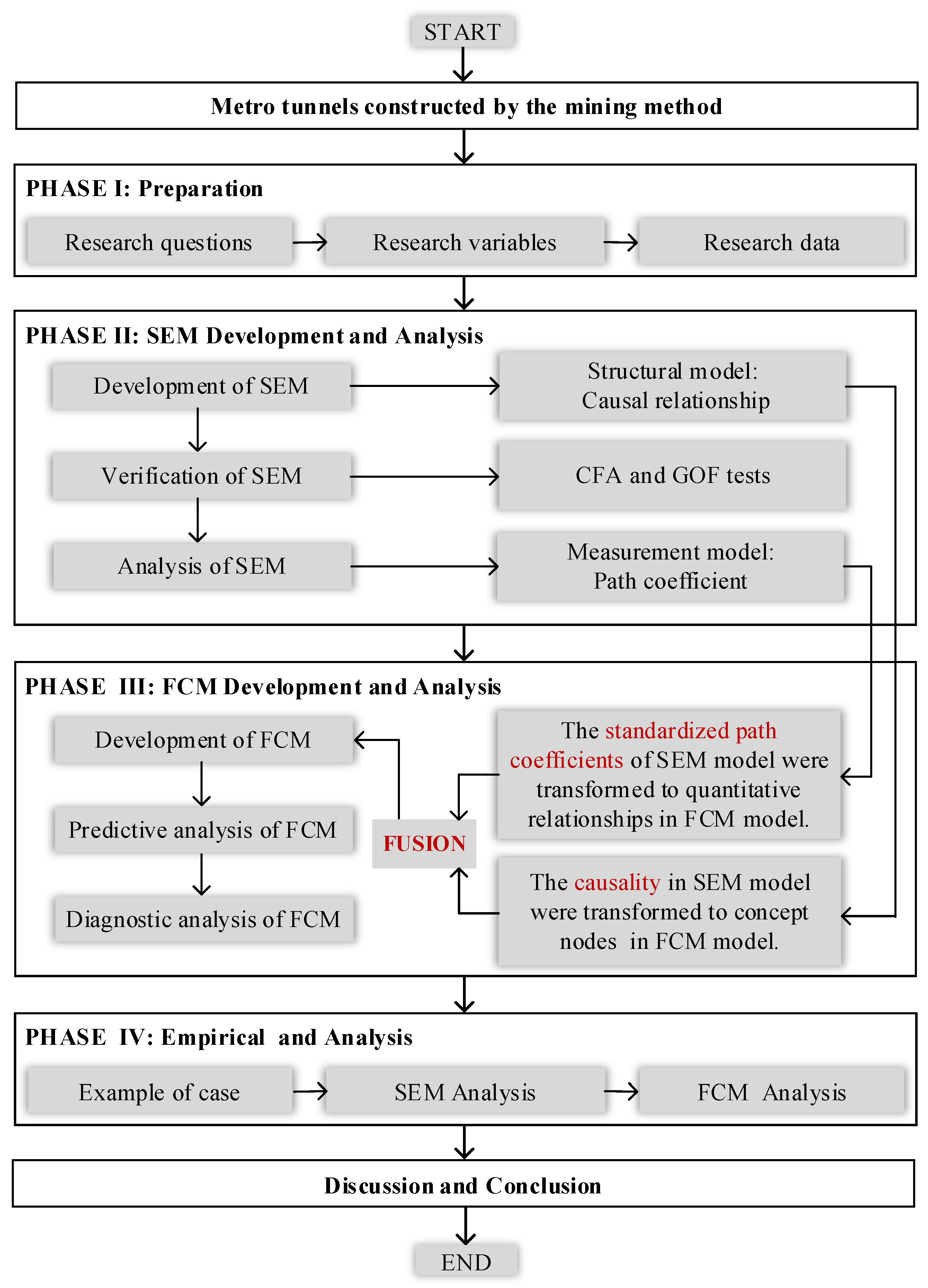
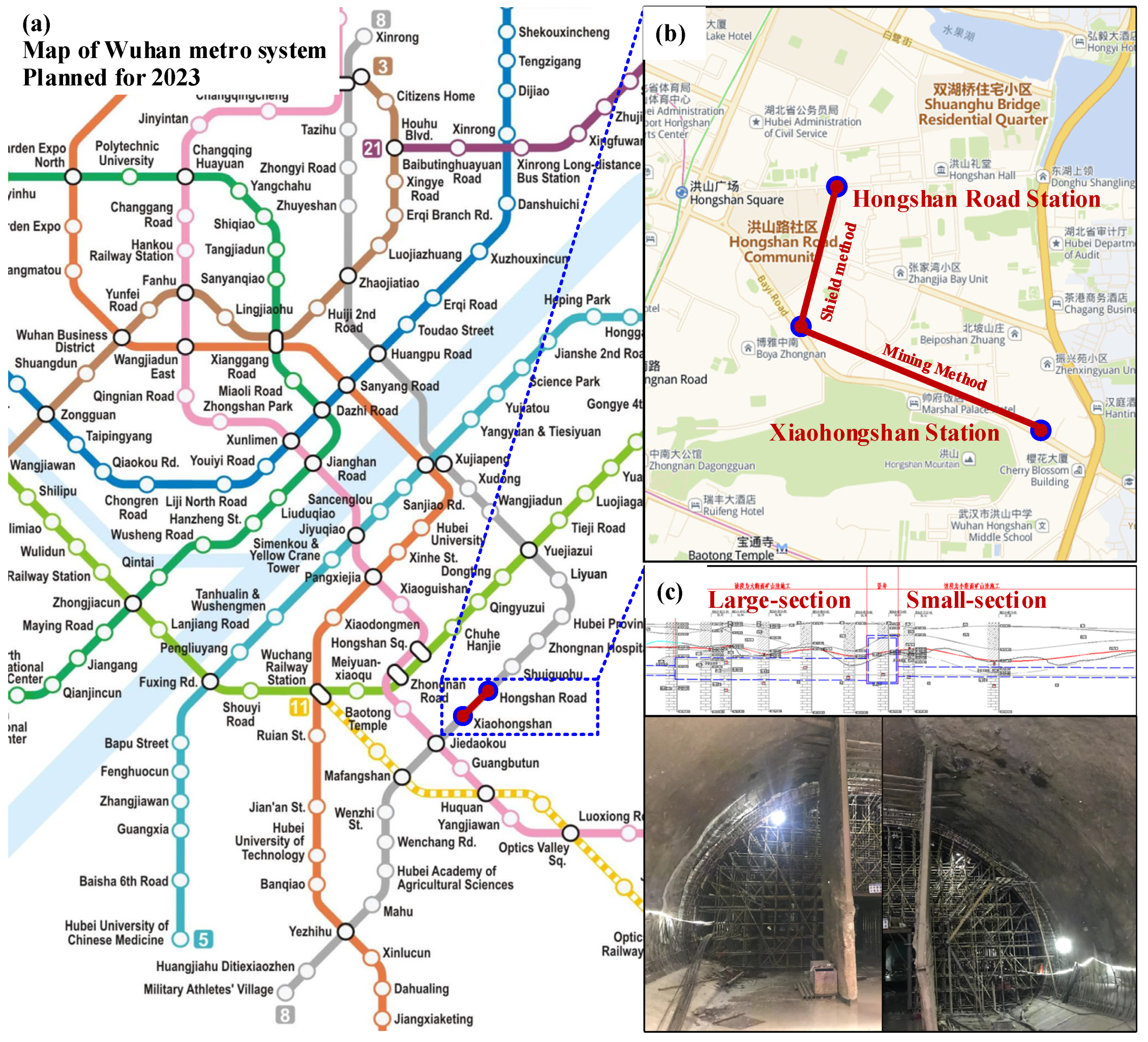
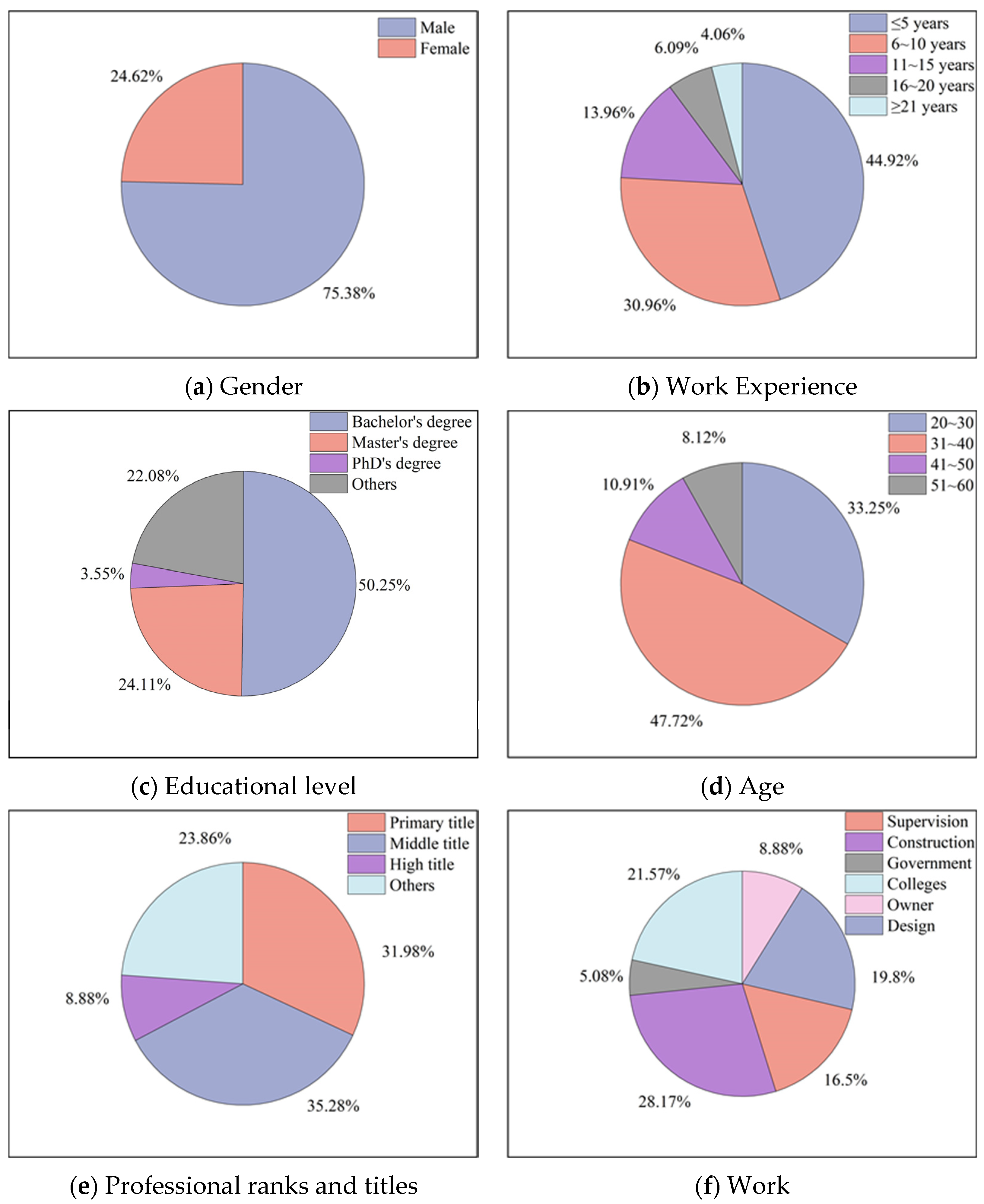
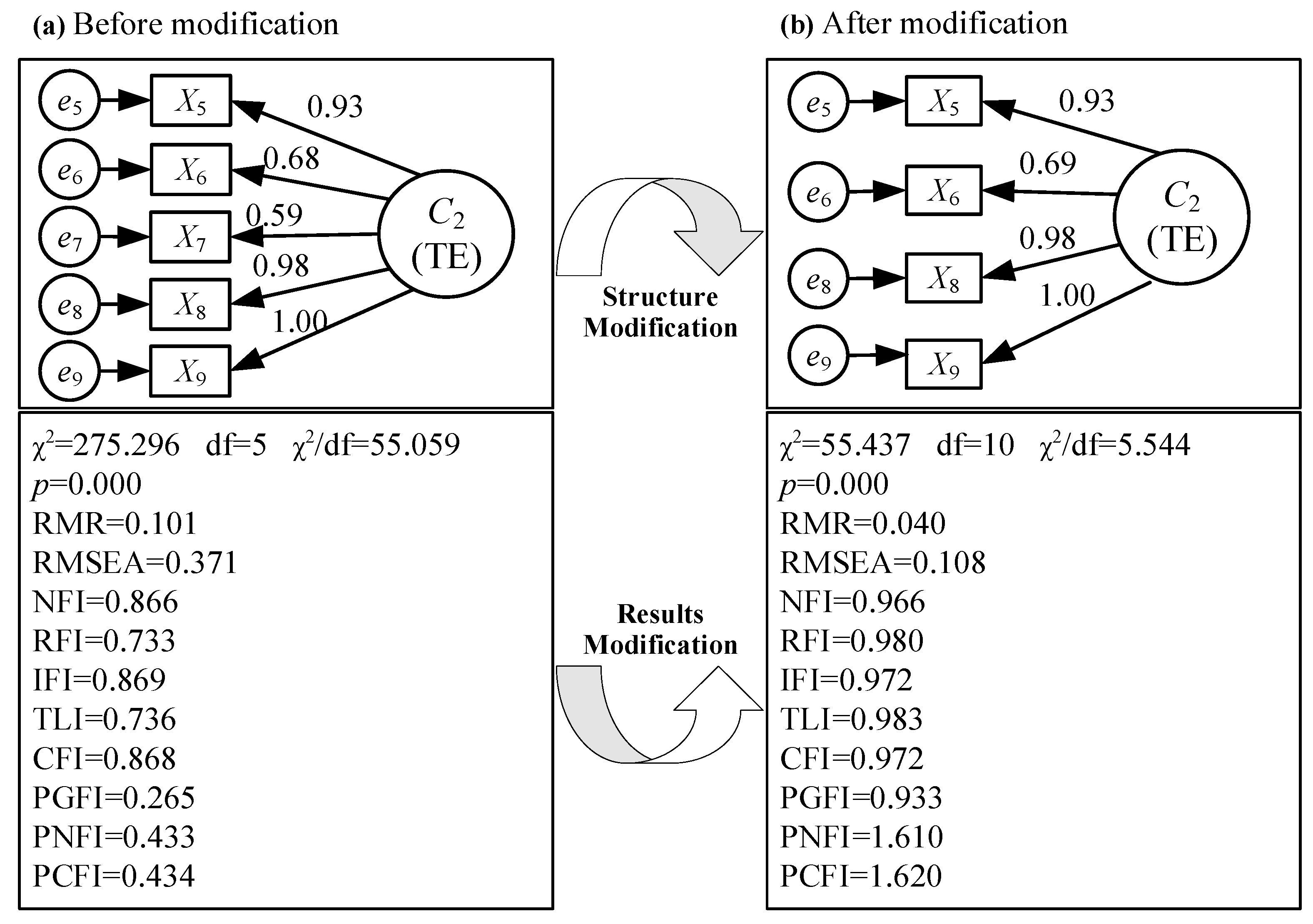
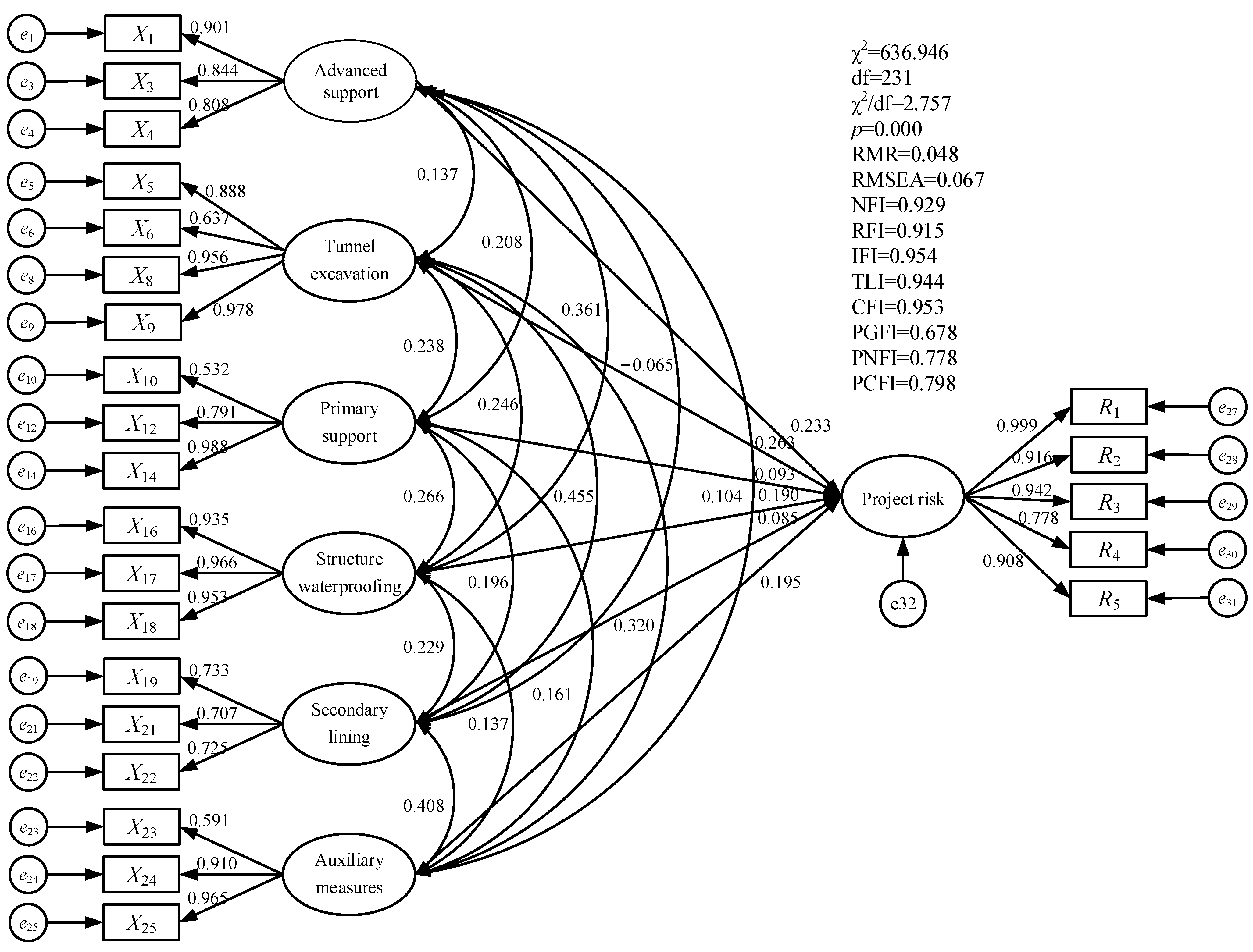

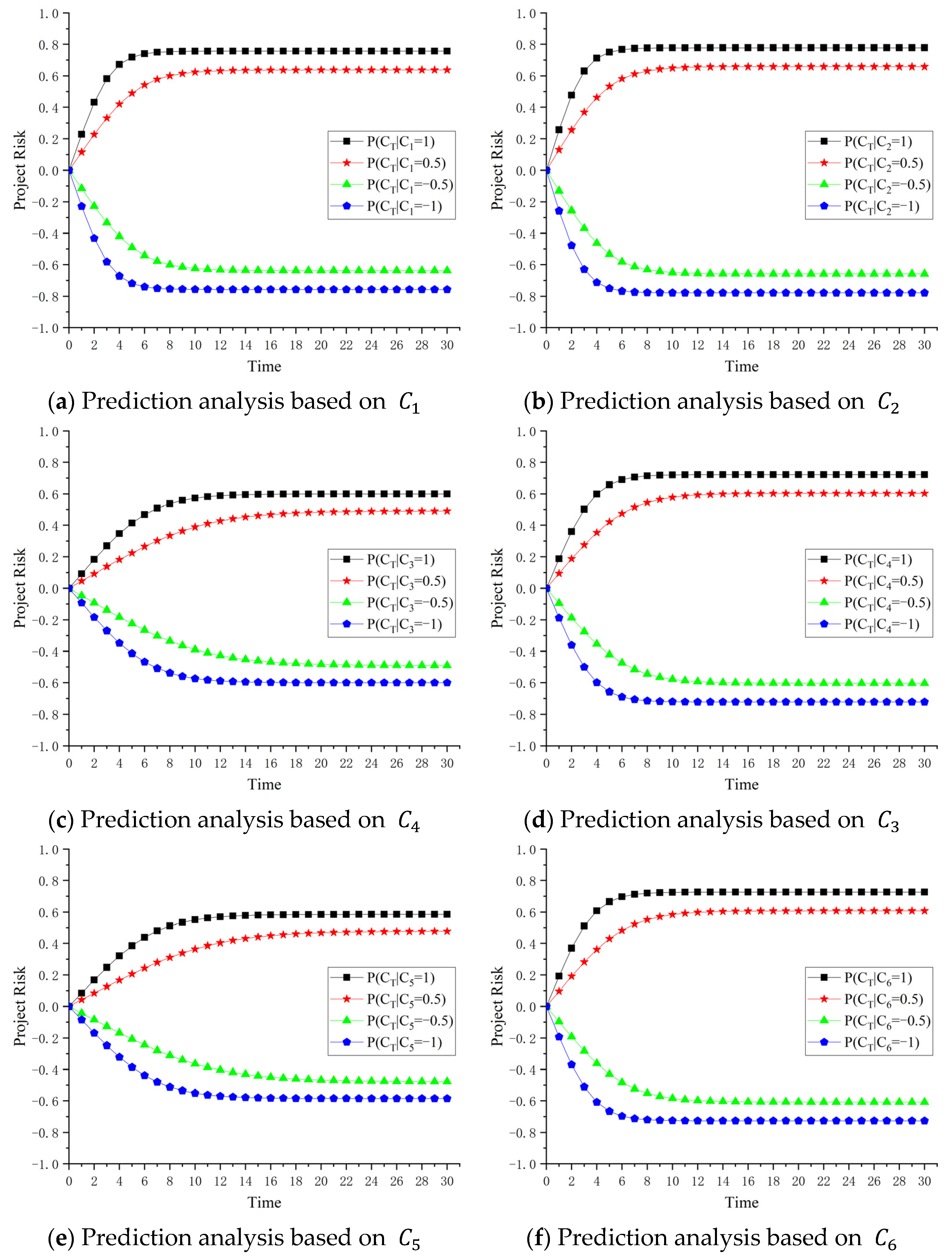
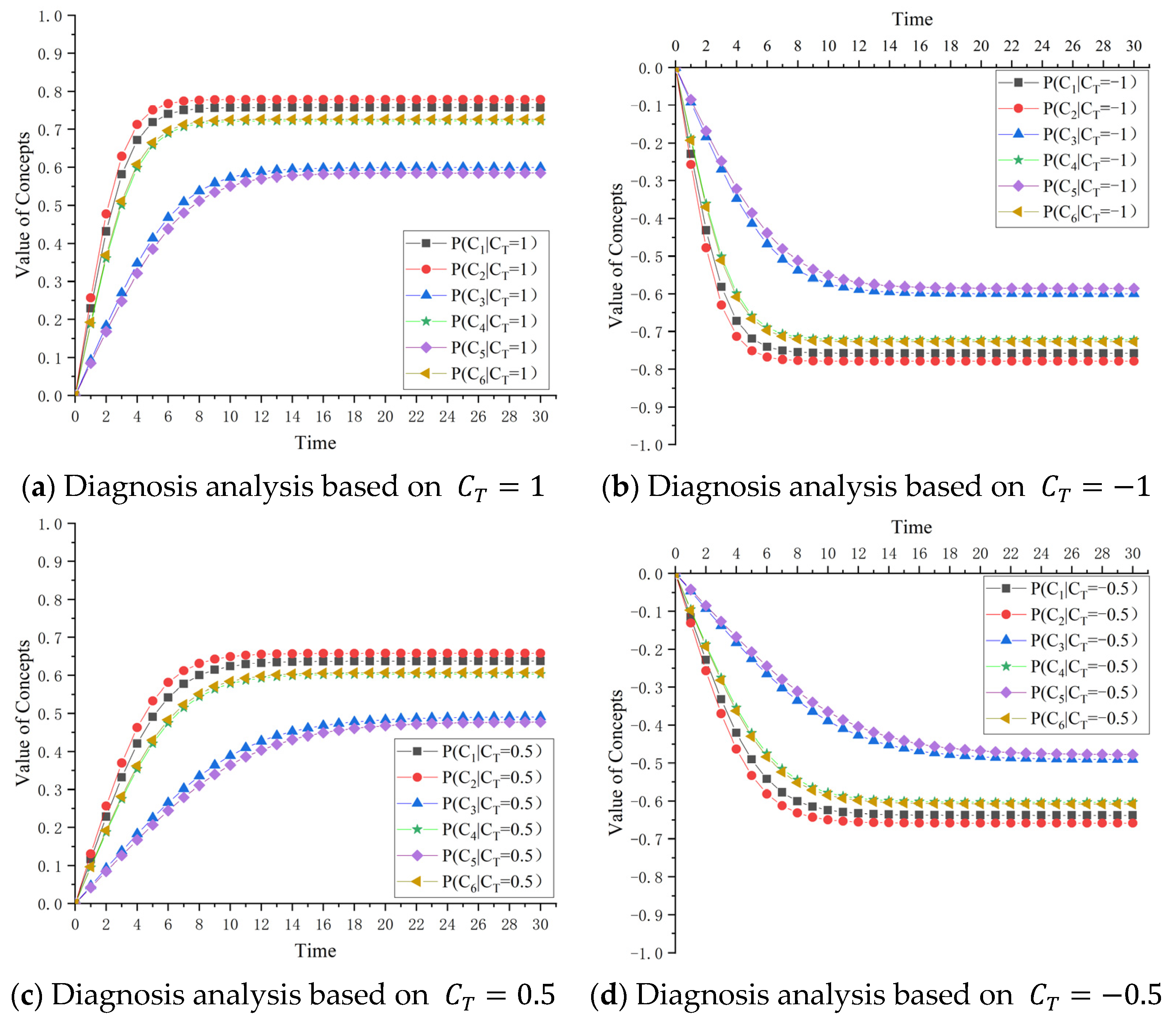
| Category | Score | Level | Criteria |
|---|---|---|---|
| CSR | 1 | Not Important | This index is not important for the safety of the mine tunnelling method of tunnel construction. |
| 2 | Less Important | This index is less important for the safety of the mine tunnelling method of tunnel construction. | |
| 3 | Neutral | This index has neutral importance with regard to the safety of the mine tunnelling method of tunnel construction. | |
| 4 | More Important | This index is more important for the safety of the mine tunnelling method of tunnel construction. | |
| 5 | Important | This index is important for the safety of the mine tunnelling method of tunnel construction. | |
| PR | 1 | Extremely Dissatisfied | Project participants are extremely dissatisfied with the project risk control. |
| 2 | Dissatisfied | Project participants are dissatisfied with the project risk control. | |
| 3 | Neutral | Project participants have a neutral attitude about the project risk control. | |
| 4 | Satisfied | Project participants are satisfied with the project risk control. | |
| 5 | Very satisfied | Project participants are extremely satisfied with the project risk control. |
| Tests Statistic | Meaning | Fitness Test Standard | |
|---|---|---|---|
| Absolute Fit Indices | RMR | Root mean square residua | <0.05 |
| RMSEA | Root mean square error of approximation | <0.05 | |
| GFI | Goodness of fit index | >0.9 | |
| AGFI | Adjusted goodness of fit index | >0.9 | |
| Relative Fit Index | IFI | Incremental fit index | >0.9 |
| CFI | Comparative fit index | >0.9 | |
| NFI | Normal fit index | >0.9 | |
| TLI | Tucker–Lewis index | >0.9 | |
| Parsimony Fit Index | PGFI | Parsimony good fit index | >0.9 |
| PNFI | Parsimony norm fit index | >0.9 | |
| CMIN/DF | Discrepancy divided by degree of freedom | <3 | |
| Measures | Mean Statistic | SD Statistic | Skewness | Kurtosis | ||
|---|---|---|---|---|---|---|
| Statistic | SD | Statistic | SD | |||
| 3.3401 | 1.01694 | −0.166 | 0.123 | 0.034 | 0.245 | |
| 3.4112 | 1.02313 | −0.174 | 0.123 | −0.078 | 0.245 | |
| 3.3883 | 1.03573 | −0.169 | 0.123 | −0.086 | 0.245 | |
| 3.4442 | 1.01800 | −0.117 | 0.123 | −0.220 | 0.245 | |
| 3.1523 | 1.04706 | 0.066 | 0.123 | −0.492 | 0.245 | |
| 2.4010 | 1.04192 | 0.591 | 0.123 | −0.294 | 0.245 | |
| 2.7335 | 0.92604 | 0.109 | 0.123 | −0.059 | 0.245 | |
| 3.1066 | 1.02081 | 0.016 | 0.123 | −0.170 | 0.245 | |
| 3.1193 | 1.02562 | 0.001 | 0.123 | −0.194 | 0.245 | |
| 3.2919 | 1.03800 | −0.072 | 0.123 | −0.195 | 0.245 | |
| 2.3477 | 1.03791 | 0.734 | 0.123 | 0.209 | 0.245 | |
| 3.2284 | 0.99802 | −0.131 | 0.123 | −0.213 | 0.245 | |
| 3.7234 | 1.08523 | −0.681 | 0.123 | −0.167 | 0.245 | |
| 3.2995 | 1.07322 | −0.259 | 0.123 | −0.274 | 0.245 | |
| 2.9873 | 1.01005 | 0.338 | 0.123 | −0.254 | 0.245 | |
| 3.0076 | 1.06885 | 0.299 | 0.123 | −0.457 | 0.245 | |
| 2.9797 | 1.01620 | 0.362 | 0.123 | −0.268 | 0.245 | |
| 2.9239 | 1.06973 | 0.152 | 0.123 | −0.319 | 0.245 | |
| 3.0533 | 1.12781 | 0.012 | 0.123 | −0.533 | 0.245 | |
| 2.9695 | 1.11163 | 0.094 | 0.123 | −0.550 | 0.245 | |
| 3.5051 | 1.13524 | −0.401 | 0.123 | −0.831 | 0.245 | |
| 2.2919 | 1.06701 | 0.799 | 0.123 | 0.059 | 0.245 | |
| 1.9645 | 0.97749 | 0.663 | 0.123 | −0.375 | 0.245 | |
| 3.5228 | 1.04150 | −0.564 | 0.123 | −0.278 | 0.245 | |
| 3.3020 | 1.06178 | −0.114 | 0.123 | −0.467 | 0.245 | |
| 2.1015 | 1.00879 | 0.827 | 0.123 | 0.191 | 0.245 | |
| 2.9746 | 1.20405 | 0.093 | 0.123 | −0.768 | 0.245 | |
| 3.0000 | 1.13020 | 0.255 | 0.123 | −0.594 | 0.245 | |
| 2.9772 | 1.15337 | 0.145 | 0.123 | −0.603 | 0.245 | |
| 2.7386 | 1.20228 | 0.276 | 0.123 | −0.629 | 0.245 | |
| 2.9061 | 1.12515 | 0.218 | 0.123 | −0.501 | 0.245 | |
| Variables | Item | Rotated Component Matrix | R2 | AVE | CR |
|---|---|---|---|---|---|
(Advanced support) | 0.879 | 0.773 | 0.738 | 0.918 | |
| 0.858 | 0.736 | ||||
| 0.862 | 0.743 | ||||
| 0.837 | 0.701 | ||||
(Tunnel excavation) | 0.885 | 0.783 | 0.700 | 0.921 | |
| 0.79 | 0.624 | ||||
| 0.785 | 0.616 | ||||
| 0.849 | 0.721 | ||||
| 0.869 | 0.755 | ||||
(Primary support) | 0.775 | 0.601 | 0.535 | 0.849 | |
| 0.508 | 0.258 | ||||
| 0.762 | 0.581 | ||||
| 0.729 | 0.531 | ||||
| 0.840 | 0.706 | ||||
(Structure waterproofing) | 0.945 | 0.893 | 0.868 | 0.963 | |
| 0.924 | 0.854 | ||||
| 0.925 | 0.856 | ||||
| 0.932 | 0.869 | ||||
(Secondary lining) | 0.911 | 0.830 | 0.624 | 0.866 | |
| 0.895 | 0.801 | ||||
| 0.578 | 0.334 | ||||
| 0.728 | 0.530 | ||||
(Auxiliary measures) | 0.755 | 0.570 | 0.612 | 0.862 | |
| 0.855 | 0.731 | ||||
| 0.848 | 0.719 | ||||
| 0.655 | 0.429 | ||||
(Project risk) | 0.885 | 0.783 | 0.719 | 0.927 | |
| 0.842 | 0.709 | ||||
| 0.859 | 0.738 | ||||
| 0.788 | 0.621 | ||||
| 0.862 | 0.743 |
| Types of Fit Indices | Indicators | Fit Criteria | Before Modification | Test Results |
|---|---|---|---|---|
| Absolute fit indices | Root mean square residual (RMR) | ≤0.08 | 0.051 | YES |
| Root mean square error of approximation (RMSEA) | ≤0.08 | 0.074 | YES | |
| Goodness-of-fit index (GFI) | ≥0.80 | 0.844 | YES | |
| Adjusted goodness-of-fit index (AGFI) | ≥0.80 | 0.807 | YES | |
| Relative fit indices | Normal fit index (NFI) | ≥0.80 | 0.909 | YES |
| Relative fit index (RFI) | ≥0.90 | 0.895 | NO | |
| Incremental fit index (IFI) | ≥0.90 | 0.936 | YES | |
| Tucker–Lewis index (TLI) | ≥0.90 | 0.926 | YES | |
| Comparative fit index (CFI) | ≥0.90 | 0.935 | YES | |
| Parsimony fit indices | Parsimonious goodness-fit-index (PGFI) | ≥0.50 | 0.684 | YES |
| Parsimonious normed fit index (PNFI) | ≥0.50 | 0.791 | YES | |
| Parsimonious comparative-fit-index (PCFI) | ≥0.50 | 0.814 | YES | |
| Chi-square/degree of freedom (χ2/df) | ≤3 | 3.151 | NO |
| Types | Indicators | Fit Criteria | Before | After | Results |
|---|---|---|---|---|---|
| Absolute fit indices | Root mean square residual (RMR) | ≤0.08 | 0.051 | 0.048 | YES |
| Root mean square error of approximation (RMSEA) | ≤0.08 | 0.074 | 0.067 | YES | |
| Goodness-of-fit index (GFI) | ≥0.80 | 0.844 | 0.881 | YES | |
| Adjusted goodness-of-fit index (AGFI) | ≥0.80 | 0.807 | 0.845 | YES | |
| Relative fit indices | Normal fit index (NFI) | ≥0.80 | 0.909 | 0.929 | YES |
| Relative fit index (RFI) | ≥0.90 | 0.895 | 0.917 | YES | |
| Incremental fit index (IFI) | ≥0.90 | 0.936 | 0.954 | YES | |
| Tucker—Lewis index (TLI) | ≥0.90 | 0.926 | 0.944 | YES | |
| Comparative fit index (CFI) | ≥0.90 | 0.935 | 0.953 | YES | |
| Parsimony fit indices | Parsimonious goodness-fit-index (PGFI) | ≥0.50 | 0.684 | 0.678 | YES |
| Parsimonious normed fit index (PNFI) | ≥0.50 | 0.791 | 0.778 | YES | |
| Parsimonious comparative-fit-index(PCFI) | ≥0.50 | 0.814 | 0.798 | YES | |
| Chi-square/degree of freedom (χ2/df) | ≤3 | 3.151 | 2.757 | YES |
| Causal Path | Standard Coefficient (R) | t Value | p |
|---|---|---|---|
| Project risk Primary support | 0.093 | 2.164 | 0.03 |
| Project risk Tunnel excavation | 0.263 | 5.476 | *** |
| Project risk Secondary lining | 0.085 | 1.438 | 0.15 |
| Project risk Auxiliary measures | 0.195 | 4.199 | *** |
| Project risk Structure waterproofing | 0.190 | 4.119 | *** |
| Project risk Advanced support | 0.233 | 4.852 | *** |
| Primary support Secondary lining | 0.196 | 3.274 | 0.001 |
| Primary support Auxiliary measures | 0.161 | 2.952 | 0.003 |
| Primary support Structure waterproofing | 0.266 | 4.949 | *** |
| Tunnel excavation Secondary lining | 0.455 | 6.893 | *** |
| Tunnel excavation Auxiliary measures | 0.320 | 5.805 | *** |
| Tunnel excavation Structure waterproofing | 0.246 | 4.588 | *** |
| Secondary lining Auxiliary measures | 0.408 | 6.307 | *** |
| Tunnel excavation Advanced support | 0.137 | 2.512 | 0.012 |
| Primary support Advanced support | 0.208 | 3.738 | *** |
| Structure waterproofing Advanced support | 0.361 | 6.136 | *** |
| Secondary lining Advanced support | −0.065 | −1.054 | 0.292 |
| Auxiliary measures Advanced support | 0.104 | 1.868 | 0.062 |
| Primary support Tunnel excavation | 0.238 | 4.405 | *** |
| Secondary lining Structure waterproofing | 0.229 | 3.743 | *** |
| Auxiliary measures Structure waterproofing | 0.137 | 2.582 | 0.01 |
| −0.7576 | −0.6376 | 0.6376 | 0.7576 | |
| −0.7785 | −0.6583 | 0.6583 | 0.7785 | |
| −0.5997 | −0.4909 | 0.4909 | 0.5997 | |
| −0.7222 | −0.6033 | 0.6033 | 0.7222 | |
| −0.5849 | −0.4776 | 0.4776 | 0.5849 | |
| −0.7267 | −0.6076 | 0.6076 | 0.7267 |
| −0.7576 | −0.7785 | −0.5997 | −0.7222 | −0.5849 | −0.7267 | |
| −0.6376 | −0.6583 | −0.4909 | −0.6033 | −0.4776 | −0.6076 | |
| 0.6376 | 0.6583 | 0.4909 | 0.6033 | 0.4776 | 0.6076 | |
| 0.7576 | 0.7785 | 0.5997 | 0.7222 | 0.5849 | 0.7267 |
| Latent Variables | Standardized Path Coefficient | Weight I | Rank I | Observational Variables | Standardized Path Coefficient | Weight II | Rank II | Weight III | Rank III |
|---|---|---|---|---|---|---|---|---|---|
(Advanced support) | 0.233 | 0.220 | 2 | 0.901 | 0.196 | 1 | 0.071 | 4 | |
| 0.844 | 0.183 | 2 | 0.066 | 5 | |||||
| 0.808 | 0.176 | 3 | 0.063 | 8 | |||||
(Tunnel excavation) | 0.263 | 0.248 | 1 | 0.888 | 0.227 | 3 | 0.082 | 3 | |
| 0.637 | 0.163 | 4 | 0.059 | 12 | |||||
| 0.956 | 0.244 | 2 | 0.088 | 2 | |||||
| 0.978 | 0.250 | 1 | 0.090 | 1 | |||||
(Primary support) | 0.093 | 0.088 | 5 | 0.532 | 0.043 | 3 | 0.016 | 19 | |
| 0.791 | 0.064 | 2 | 0.023 | 15 | |||||
| 0.988 | 0.080 | 1 | 0.029 | 14 | |||||
(Structure waterproofing) | 0.19 | 0.179 | 4 | 0.935 | 0.172 | 3 | 0.062 | 10 | |
| 0.966 | 0.178 | 1 | 0.064 | 6 | |||||
| 0.953 | 0.176 | 2 | 0.063 | 9 | |||||
(Secondary lining) | 0.085 | 0.080 | 6 | 0.733 | 0.058 | 1 | 0.021 | 16 | |
| 0.707 | 0.056 | 3 | 0.020 | 18 | |||||
| 0.725 | 0.058 | 2 | 0.021 | 17 | |||||
(Auxiliary measures) | 0.195 | 0.184 | 3 | 0.591 | 0.108 | 3 | 0.039 | 13 | |
| 0.910 | 0.166 | 2 | 0.060 | 11 | |||||
| 0.965 | 0.176 | 1 | 0.063 | 7 |
Disclaimer/Publisher’s Note: The statements, opinions and data contained in all publications are solely those of the individual author(s) and contributor(s) and not of MDPI and/or the editor(s). MDPI and/or the editor(s) disclaim responsibility for any injury to people or property resulting from any ideas, methods, instructions or products referred to in the content. |
© 2023 by the authors. Licensee MDPI, Basel, Switzerland. This article is an open access article distributed under the terms and conditions of the Creative Commons Attribution (CC BY) license (https://creativecommons.org/licenses/by/4.0/).
Share and Cite
Wang, Q.; Xiong, Z.; Zhu, K.; Guo, P. Construction Safety Risks of Metro Tunnels Constructed by the Mining Method in Wuhan City, China: A Structural Equation Model-Fuzzy Cognitive Map Hybrid Method. Buildings 2023, 13, 1335. https://doi.org/10.3390/buildings13051335
Wang Q, Xiong Z, Zhu K, Guo P. Construction Safety Risks of Metro Tunnels Constructed by the Mining Method in Wuhan City, China: A Structural Equation Model-Fuzzy Cognitive Map Hybrid Method. Buildings. 2023; 13(5):1335. https://doi.org/10.3390/buildings13051335
Chicago/Turabian StyleWang, Qiankun, Zhihua Xiong, Ke Zhu, and Peiwen Guo. 2023. "Construction Safety Risks of Metro Tunnels Constructed by the Mining Method in Wuhan City, China: A Structural Equation Model-Fuzzy Cognitive Map Hybrid Method" Buildings 13, no. 5: 1335. https://doi.org/10.3390/buildings13051335
APA StyleWang, Q., Xiong, Z., Zhu, K., & Guo, P. (2023). Construction Safety Risks of Metro Tunnels Constructed by the Mining Method in Wuhan City, China: A Structural Equation Model-Fuzzy Cognitive Map Hybrid Method. Buildings, 13(5), 1335. https://doi.org/10.3390/buildings13051335








